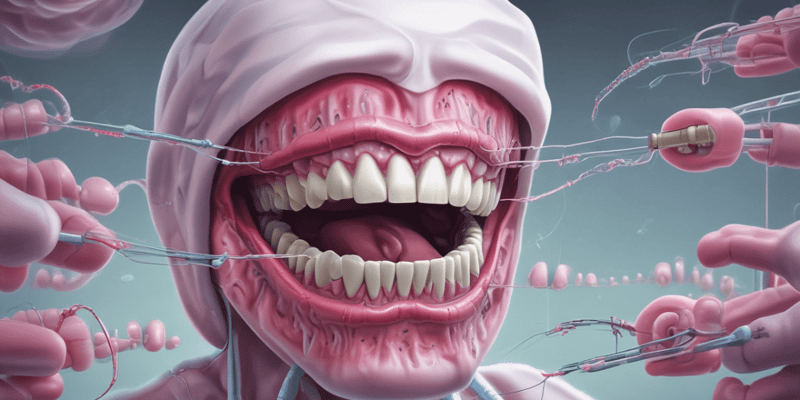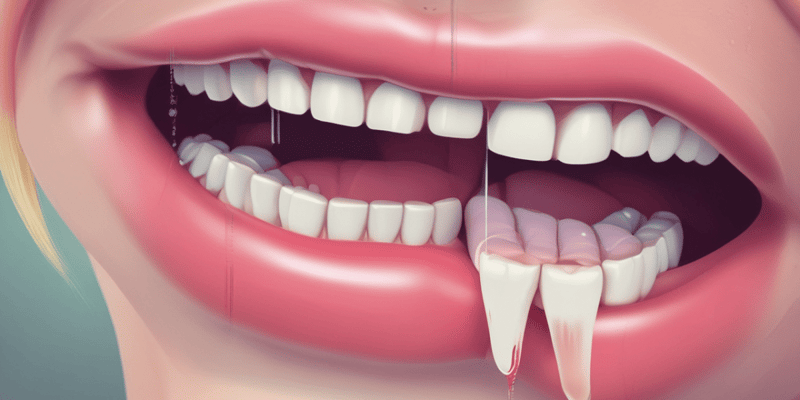Podcast Beta
Questions and Answers
What is the primary goal of surgical drainage in the context of non-suppurative space infections?
How does surgical drainage improve local blood supply to infected tissues?
Which mechanism of surgical drainage helps in obtaining adequate culture specimens?
What role does surgical drainage play in managing cellulitis?
Signup and view all the answers
Which of the following is NOT a benefit of surgical drainage in treating infections?
Signup and view all the answers
What enzyme produced by staphylococci might lead to fibrin deposition in an abscess?
Signup and view all the answers
In which type of abscess does the pus remain contained within the alveolar bone?
Signup and view all the answers
What is the primary mechanism through which an abscess may result in increased necrosis?
Signup and view all the answers
What characterizes the late stage of an acute dentoalveolar abscess?
Signup and view all the answers
What can occur if a spontaneously draining infection re-closes?
Signup and view all the answers
What symptoms are associated with the early stage of acute dentoalveolar abscess?
Signup and view all the answers
What is the hallmark of the resolution stage after an infection is drained?
Signup and view all the answers
What may result from a chronic infection of non-virulent organisms?
Signup and view all the answers
Why is regional nerve block anesthesia preferred over infiltration techniques?
Signup and view all the answers
What is a significant reason for performing fiber-optic intubation in patients?
Signup and view all the answers
Where should incisions ideally be placed in infected cases?
Signup and view all the answers
Which method is recommended for drainage of abscesses?
Signup and view all the answers
What must be avoided when making incisions intraorally?
Signup and view all the answers
What is a crucial step before performing an incision for abscess drainage?
Signup and view all the answers
What length should the stab incision be for efficient abscess drainage?
Signup and view all the answers
Why should incisions be placed parallel to skin creases?
Signup and view all the answers
What is the primary purpose of inserting a drain into an abscess cavity?
Signup and view all the answers
When should drains typically be removed from infected wounds?
Signup and view all the answers
Which supportive therapy is focused on improving the hydration of a patient with an infection?
Signup and view all the answers
What is NOT a reason to maintain adequate nutritional status in patients with infections?
Signup and view all the answers
How much hydration should an ambulatory patient with infection aim for daily?
Signup and view all the answers
What role does the corrugated rubber drain play in relation to the abscess cavity?
Signup and view all the answers
Which of the following is an important consideration in the supportive therapy for patient recovery?
Signup and view all the answers
What is indicated by maintaining bed rest as part of supportive therapy?
Signup and view all the answers
What is the primary reason that odontogenic infections may spread within bone if left untreated?
Signup and view all the answers
Which of the following statements about the cellulitis stage of infection is true?
Signup and view all the answers
In which phase of an oral infection does the inoculation stage occur?
Signup and view all the answers
What characterizes the abscess stage of an oral infection?
Signup and view all the answers
What role do enzymes produced by streptococci play during the cellulitis stage?
Signup and view all the answers
Which bacteria are most commonly isolated from odontogenic infections?
Signup and view all the answers
Which factor does NOT influence the spread of an odontogenic infection?
Signup and view all the answers
What outcome is specifically associated with the acuteness phase of an oral infection?
Signup and view all the answers
Study Notes
Odontogenic Infections
- Anaerobic bacteria: Bacteroides spp. are the most isolated anaerobic bacteria in odontogenic infections.
- Combination of Bacteria: 50-60% of odontogenic infections involve both aerobic and anaerobic bacteria.
-
Local Factors: The anatomy of the infected area influences infection spread.
- Bone thickness: Thinner bone allows for easier spread.
- Muscle attachment: Proximity and type of muscle attachment affect spread.
- Faciolingual location: Location of the infection source influences spread.
-
Phases and Fates of Oral Infection:
- Resolution: Successful healing and elimination of infection.
- Acuteness: The active stage of infection with rapid spread.
- Chronicity: Long-standing infection with localized necrosis.
-
Acute Stage:
- Inoculation (edema) stage: Characterized by soft, doughy swelling, usually occurs within 3 days.
- Cellulitis stage: Occurs between days 3 and 5, marked by firm, painful swelling.
- Abscess stage: Characterized by localized pus formation, swelling becomes fluctuant in consistency.
-
Abscess Types:
- Acute periapical abscess: Localized within the alveolar bone.
- Acute dentoalveolar abscess: Infection extends beyond the alveolar bone into surrounding soft tissues.
- Acute periodontal abscess: Abscess formation in the periodontal structures.
- Acute pericoronal abscess: Abscess associated with a partially erupted tooth.
-
Chronic Stage:
- Characterized by localized necrosis due to long-standing infection.
- Infection may spontaneously drain, temporarily resolving or forming a fistula/sinus tract.
-
Acute Dentoalveolar Abscess (ADAA):
- Definition: Inflammation of periapical tissues due to bacteria from infected root canals.
-
Stages:
- Early Stage: ADAA without soft tissue involvement.
- Late Stage: ADAA with soft tissue involvement.
-
ADAA Signs and Symptoms:
-
Early stage (Central Bone Abscess):
- Tooth elongation sensation.
- Severe throbbing pain.
- Systemic symptoms (fever, chills, malaise, muscle/joint pain, lymphadenitis).
-
Late Stage (Subperiosteal Abscess):
- Relief of throbbing pain as pus escapes into soft tissues.
-
Early stage (Central Bone Abscess):
-
Surgical Drainage (Incision and Drainage):
- Purpose: To facilitate healing by reducing bacterial load and pressure on the infected tissues.
- Benefits: Improves blood flow, allows for antibiotic penetration, reduces airway compression in Ludwig's angina.
- Procedure: Incision placed at the most dependent area, parallel to skin creases, and supported by healthy tissue.
-
Anesthesia for Drainage:
- Regional nerve block: Preferred over infiltration due to infected tissue's acidity and risk of seeding infection.
- Oro/nasal tracheal intubation: May be necessary for patients with trismus or infections affecting the oropharynx.
-
Guidelines for Incision Placement:
- Most dependent areas.
- Parallel to skin creases.
- Esthetically acceptable locations.
- Supported by healthy subcutaneous tissue.
- Intraoral incisions avoiding frenula attachments and parallel to nerve fibers.
- Removal of the cause (e.g., infected tooth, necrotic bone, foreign body) during drainage.
-
Hilton's Method of Abscess Drainage:
- Antisepsis: Area disinfected with antiseptic solution.
- Anesthesia: Regional block technique for anesthesia to prevent spreading infection.
- Incision: Stab incision made at the most dependent area, extending through skin and subcutaneous tissue.
- Exploration: Using closed forceps, the abscess cavity is explored and pus collected for culture and sensitivity testing.
- Irrigation: Abscess cavity is irrigated with antiseptic solution.
- Drainage: Corrugated rubber drain is inserted and secured to the incision edge.
-
Drain Purpose:
- To allow for the drainage of pus and fluids, keeping the wound patent.
- Facilitates debridement by irrigation.
-
Drain Removal:
- Drains are removed once drainage has decreased significantly, typically after 2-7 days.
-
Supportive Therapy:
- Systemic Disease Control: Adequate management of conditions like diabetes.
- Antibiotics: Administration of appropriate antibiotics.
- Hydration: Essential for fluid loss due to fever and infection.
- Nutritional Support: Maintain adequate calorie and protein intake.
- Analgesics: To manage pain.
- Bed rest: When appropriate.
- Heat Application: Moist heat packs or mouth rinses.
- Wound Care: Frequent irrigation, dressing changes and drain removal.
Studying That Suits You
Use AI to generate personalized quizzes and flashcards to suit your learning preferences.
Related Documents
Description
Test your understanding of odontogenic infections, focusing on the role of anaerobic bacteria, the anatomy influencing infection spread, and the phases of oral infection. This quiz covers key concepts, bacterial interactions, and the acute stage of infection.



